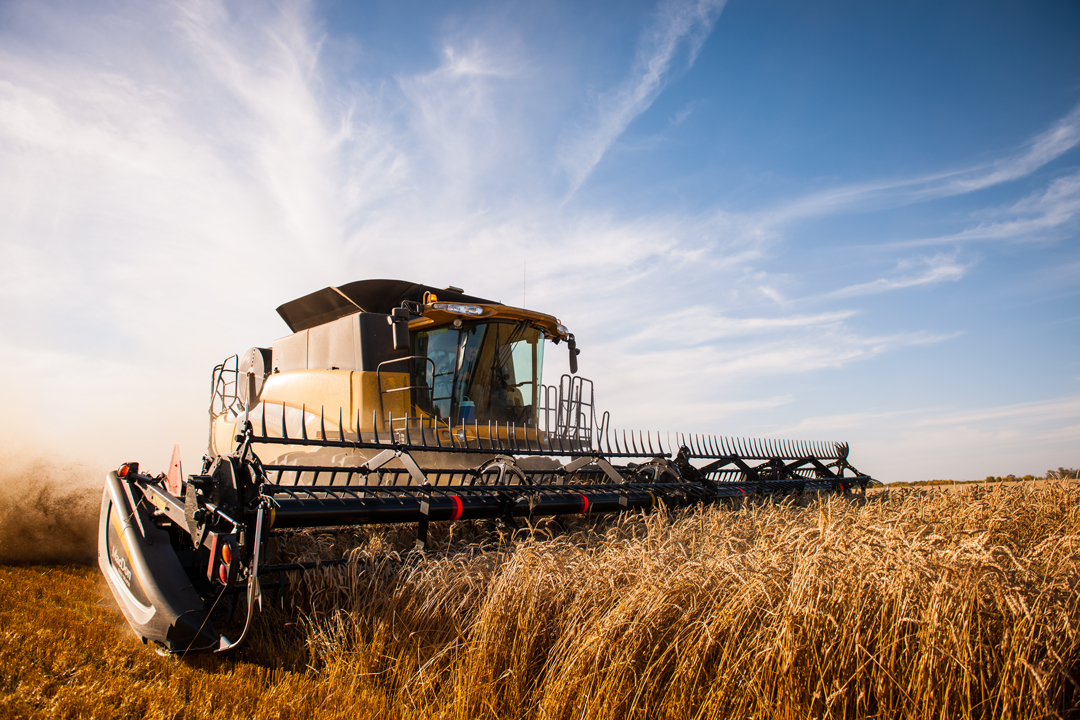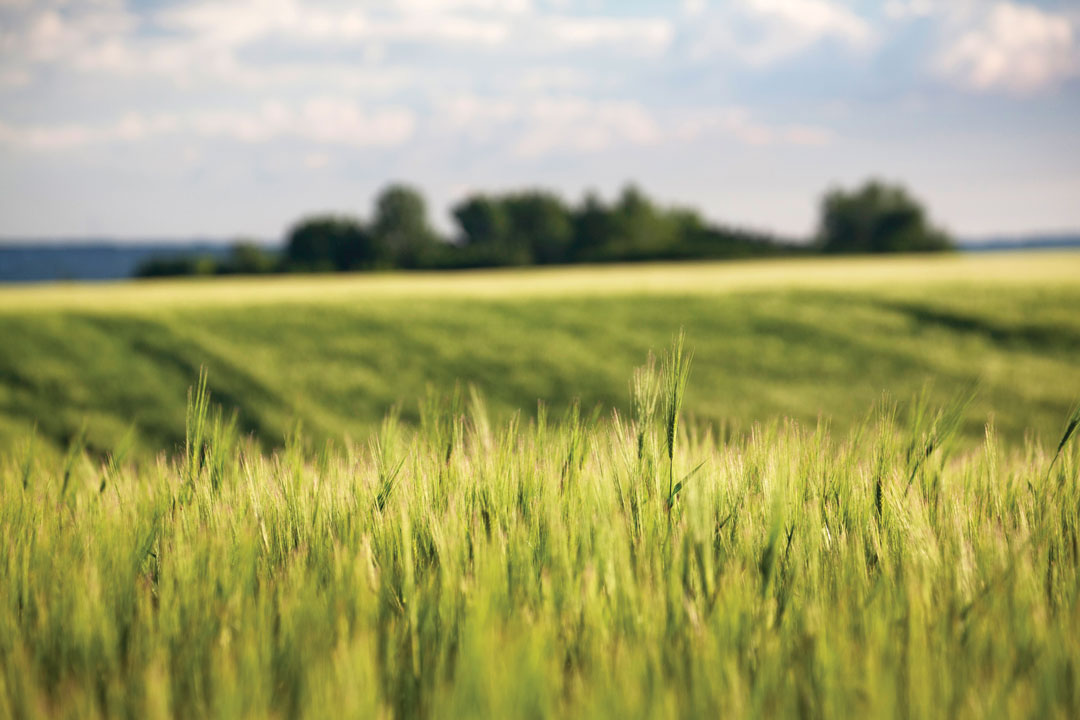CREDIT WHERE IT’S DUE
BY IAN DOIG
While the nation expects agriculture to contribute to long-range carbon emissions reductions targets, agriculture has made huge gains in sustainability since the early 1990s. Naturally, farmers are frustrated by the lack of recognition for these positive developments.
To address this, a team of researchers led by Stuart Smyth, associate professor at the University of Saskatchewan’sDepartment of Agricultural and Resource Economics, conducted phase one of the Crop Rotation Survey. Smyth is the university’s agri-food innovation and sustainability chair, a position funded in part by the Alberta Wheat Commission and Alberta Barley. He also maintains SAIFood.ca, a website that demystifies agricultural policy, research and innovation for the public.
The survey project gathered wide-ranging data on the evolution of field practices in Saskatchewan. The data it generated will provide insight into agricultural greenhouse gas emissions and carbon sequestration as well as soil stewardship. Published in October of 2021, the first of a number of research papers that will be spun off the project found surprisingly high carbon sequestration gains.
The survey is now open to farmers in Manitoba and Alberta.
GrainsWest: Farmers want credit for sustainability gains they’ve made in recent decades. How will this project help?
Stuart Smyth: The objective of our survey is to quantify the change in carbon sequestration. We will measure the change in greenhouse gas emissions from crop production as well. We’re in the process of gathering and analyzing that data. The one paper we’ve put out looks at the change in carbon sequestration in Saskatchewan soils.
We want to expand to determine whether Prairie agriculture is a total emitter or net sink. And if it’s a net sink, how much is being sequestered annually? We need hard data to provide to policymakers.
GW: How important is this information?
SS: Quantifying changes in greenhouse gas emissions, carbon sequestration, soil organic carbon, the very things we’re trying to do with our project, are part of what Agriculture and Agri-Food Canada is requesting in their research documents. Our research program is cutting-edge in this area because we’re doing what Ag Canada is asking for.
GW: How will the survey results be used?
SS: Can farmers get some revenue from this? I’m hopeful our research will contribute to that, and the public gains better insight into what is fundamentally important for producing Canada’s food. [The public may] have the impression this can be done through a production process where we don’t use chemicals and don’t use synthetic fertilizers. Yes, food can be produced that way, but it’s going to be several factors higher in cost. I haven’t talked to anybody who says food prices aren’t high enough. This is good timing to help inform Canadians as to what we need to do. What technologies do we need to ensure we minimize food price increases? And to do that, we need really good weed control, efficient fertilizer use and these other complementary technologies.
GW: During the pandemic, ag supply chain stories appeared on the nightly news. Does this indicate farm issues can grab the public’s attention?
SS: Media is reflecting public desire to know more about food, why food prices are high and what can help to mitigate price increases. SAIFood.ca is now ranked around 7,000 in terms of Canadian websites. Five years ago, we weren’t even in the top 100,000 websites. This indicates public appetite for trusted information.
GW: Why does the project focus on 1991 to 1994 and 2016 to 2019?
SS: To inform policymakers, we’re gathering baseline data. This is why we’ve gone back to the early ’90s, prior to the commercialization of herbicide tolerant and genetically modified [GM] crops. This is because the commercialization of GM crops in the mid- to latter ’90s was a transformational innovation that fundamentally changed crop production on the Prairies.
We’re getting farmers to pick a field they farmed in the early ’90s and they still farm today. They tell us what tractor they used, how many passes they made over the field, how much fuel it burned per hour. We’re also capturing innovations within equipment. We know that engines are more efficient, there’s more horsepower per hour of use today, but better fuel efficiency. We’ll analyze the data over the coming months.
GW: What will the data produce?
SS: We hope to quantify productivity increases versus acres in production in Prairie agriculture. We know, for example, over a 30-year period, Saskatchewan alone has removed more than 10 million acres of summer fallow. Someone could say, well, chemical and fertilizer use has increased substantially in Saskatchewan, so that’s a negative for the environment. But we need to look at that within the context of how many acres were being used to produce crops. Chemical use may have changed so we’re actually using fewer chemicals per acre of production than 30 years ago.
Then we can look at what’s changing in terms of input use productivity and spillovers. I’ve talked to farmers who have been able to get such efficient weed control from putting on HT canola that they come in with a pulse crop, and some years, they don’t even have to spray for weeds the following spring. Because the weed control the previous year was so good, the threshold of weeds is low enough in the subsequent crop it doesn’t pay them to spray.
Those are the verbal stories and peer-reviewed, published evidence we can tell to policymakers that give them the insights they just don’t have.
GW: You found Saskatchewan farms have gone from producing carbon to sequestering it. What does this say about the importance of quantifying the environmental impacts of farm management practices?
SS: We were confident Saskatchewan had become a carbon sink. Largely because removing 10 million acres of summer fallow on an annual basis has to have an impact. The surprise was how significant that change was, how important that carbon sequestration is for sustainability and that it’s very much a systems model. If we remove one thing, sustainability takes a substantial hit.
We can show politicians sustainability is due to these different factors. If you significantly cut one of those factors, you damage agriculture’s potential to contribute to Canada’s objectives for climate change. These innovative technologies are fundamentally important to our success.
GW: How can agriculture leverage this information?
SS: There’s room for improvement, but we can use this as evidence our industry has become increasingly sustainable. This first paper has gotten a lot of recognition. I’ve talked to people within the industry and policymakers in Ottawa, and everybody says we just need more of this.
GW: The general public may be surprised to learn farm chemistry supports carbon sequestration and banning GM crops may be counterproductive on this front. Is it possible to sway negative public perception in these areas?
SS: We’re getting there. Canadians have a high level of trust in farmers. Particularly that they are good stewards of the land. If farmers can communicate through their organizations, social media, whatever platforms they choose, the public is looking for this information.
It can be connected then to the increase in food prices. Without this technology our yield drops by X per cent. That means food prices could be expected to rise because of lower production. The public is very aware of food prices going up, and is more open minded: “OK, maybe my opposition to some of these things was misinformed. I would prefer to see these technologies available to increase yield and help keep my food costs down.”
GW: Why did you open that second phase of the study to Manitoba and Alberta farmers?
SS: We expanded it to be able to give the Prairie-wide story and quantify what’s changed in dryland agriculture. Farmers can do a quick online registration [see link below] and then we send them an individual link to the survey.
GW: What additional questions can potentially be answered with the data collected by this project?
SS: We hope to do some forecasting. Now we don’t have insect resistant canola. But we’ll be able to use our data to model the potential impact of insect resistant canola. And we can look at the use of insecticides based on rates of farmer adoption. We’re able to use this to show how more investment in innovative aspects of agriculture can further contribute to sustainability.
GW: What should farmers know about the value of the Crop Rotation Survey?
SS: We’ve got a fantastic opportunity. A lot of times the ag sector feels frustrated Ottawa doesn’t listen, but [the government] is saying if you can provide us with this knowledge, we’ll provide funding to generate it. I encourage farmers to participate in this survey because we won’t have a better opportunity to inform policymakers about what’s going on unless farmers get involved and share their data. And for that, we acknowledge their time has value and we’re compensating them up to $200 to participate in these surveys.
The Crop Rotation Survey will remain open throughout 2022. To participate, visit: www.surveymonkey.ca/r/CRSPrairieRegistration2021







Comments